iPhone 17 vs. iPhone 16 Comparison: Biggest Differences Explained
With the iPhone 17 now available, you might be debating whether to buy it or opt for the discounted iPhone 16. The iPhone 17 starts at $829, the same price as the iPhone 16 at launch, but with 256GB storage instead of 128GB. The iPhone 16 now has a $100 discount, but its base model comes with just 128GB.
So, should you save money or invest in the latest iPhone? From camera quality to display and battery life, here's a quick iPhone comparison to help you decide which model offers the best value for your needs.
Part 1: iPhone 17 vs. iPhone 16
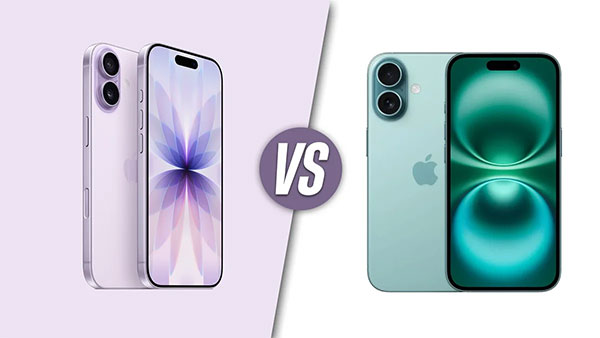
The iPhone 16 was a bit underwhelming, offering just a faster chip and a new Camera Control button, but still stuck with a 60Hz display. The iPhone 17 changes that. It's the first standard iPhone to get a 120Hz ProMotion screen, brighter display for outdoor use, a sharper 18 MP selfie camera, better battery life, and faster charging.
Overall, the iPhone 17 brings significant upgrades, making it a solid choice unless you really need the Pro's telephoto camera.
|
iPhone 17
|
iPhone 16
|
|
6.3" OLED
|
6.1" OLED
|
|
1-120Hz ProMotion with Always-On display
|
60Hz, no Always-On
|
|
Slimmer bezels
|
Thicker bezels
|
|
A19 chip (3nm)
|
A18 chip (3nm)
|
|
8GB RAM
|
8GB RAM
|
|
18 MP Center Stage
|
12 MP selfie camera
|
|
Up to 30 hrs video playback
|
Up to 22 hrs video playback
|
|
50% in ~20 min (40W adapter)
|
50% in ~30 min (20W adapter)
|
|
Up to 25W (MagSafe/Qi2)
|
Up to 25W (MagSafe/Qi2)
|
|
New Spliced seamless frame
|
Sharper edges
|
Design and Size
The iPhone 17 builds on the iPhone 16's aluminum and glass design, featuring Ceramic Shield 2, which is three times more scratch-resistant than before. However, unlike the iPhone 17 Pro and Air models, the back isn't made of Ceramic Shield 2.
The iPhone 17 is slightly larger and heavier, with slimmer bezels around its 6.3-inch display.
Apple introduces new colors for the iPhone 17: Black, Lavender, Mist Blue, Sage, and White. In contrast, the iPhone 16 offered Pink, Teal, Ultramarine, Black, and White.
Display
This year, the iPhone 17 introduces a major upgrade with a 120Hz ProMotion OLED display. It's not just faster— the base model also drops to 1Hz, allowing the Always-On display feature. Meanwhile, the iPhone 16 still sticks with a 60Hz refresh rate, which feels pretty behind compared to most other smartphones today.
Apple also boosted outdoor brightness on the iPhone 17, which now reaches a peak of 3000 nits in bright sunlight, compared to the iPhone 16's 2000 nits. Both phones can reach 1600 nits for HDR content, but the iPhone 17 will be much easier to see under the sun.
Face ID remains the only biometric option for both models.
Performance and Software
The iPhone 17 comes with the new A19 chip, offering better efficiency and smoother performance than the A18 in the iPhone 16. While both models have 8 GB of RAM, the iPhone 17 starts with 256 GB of storage, compared to the 128 GB in the iPhone 16, all without changing the starting price of $799.
On the software side, both devices will run iOS 26, which brings new features like the sleek “Liquid Glass” design, Call Screening, Live Translation, and smarter AI-powered features for a more intuitive user experience. The iPhone 16 will also receive this update on the same day as the iPhone 17's release.
Camera
The iPhone 16 introduced a vertical camera layout, keeping the same 48 MP main and 12 MP ultrawide cameras from the iPhone 15. However, with the iPhone 17, Apple has upgraded the ultrawide to 48 MP, offering sharper details and improved macro shots. It's likely the same 48 MP ultrawide found in the Pro models.
On the front, the iPhone 17 now features an 18 MP Center Stage selfie camera. This camera offers a wider view, more stable 4K HDR video, and Dual Capture, allowing you to record with both the front and rear cameras simultaneously.
Battery and Charging
Apple claims the iPhone 17 offers up to 30 hours of video playback, a significant jump from the iPhone 16's 22-hour capacity. This improvement is thanks to a larger, stacked battery and the energy-efficient A19 chip.
Charging is also quicker. Using Apple's new 40W Dynamic Power Adapter, the iPhone 17 can charge up to 50% in just 20 minutes. Wireless charging remains at a 25W speed.
However, there's still one feature we're waiting for: reverse wireless charging. Even the new Pro models don't include this feature yet.
Summary: Which One to Choose?
The iPhone 17 is the upgrade the standard model needed, with a 120Hz display, 3000-nit brightness, 18MP selfie camera, and a 48MP ultrawide camera. It also offers longer battery life, faster charging, and Qi2 wireless support, making it a true flagship.
The iPhone 16, with its 60Hz screen and 12MP ultrawide, feels outdated in 2025, despite the A18 chip.
For most users, the iPhone 17 is all you need—no need to splurge on the Pro model unless you want extra features. With the same price and more storage, it's the best iPhone deal in years.
You May Be Interested in:
Part 2: iPhone 17 Pro vs. iPhone 16 Pro
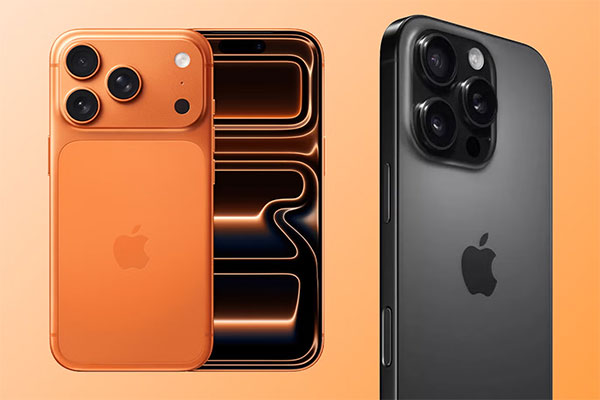
The iPhone 17 Pro brings major changes, swapping titanium for brushed aluminum with a plateau design for a bigger battery and better cooling. It also has Ceramic Shield 2 for improved scratch resistance. Powered by the A19 Pro chip, it offers faster performance and longer battery life. The camera now features a 48MP telephoto lens with 8x optical zoom.
How does it compare to the iPhone 16 Pro? I'm still waiting for my review units but have compared the specs to see if it's worth upgrading.
|
iPhone 17 Pro
|
iPhone 16 Pro
|
|
6.3" OLED display
|
6.3" OLED display
|
|
120Hz ProMotion
|
120Hz ProMotion
|
|
Aluminum + glass body
|
Titanium + glass body
|
|
A19 Pro chip
|
A18 Pro chip
|
|
12GB RAM
|
8GB RAM
|
|
Apple Intelligence
|
Apple Intelligence
|
|
24MP front camera
|
12MP front camera
|
|
Triple 48MP cameras
|
Dual 48MP + 12MP telephoto
|
|
8K video recording
|
4K video recording
|
|
Dual video recording
|
-
|
|
Apple Wi-Fi 7 chip
|
-
|
|
3700+ mAh
|
3,582 mAh
|
|
Vapor chamber cooling
|
-
|
|
50W MagSafe charging
|
25W MagSafe charging
|
|
$1099+ starting price
|
$999 starting price
|
Design
The iPhone 17 Pro introduces a fresh design, moving away from the familiar look of the iPhone 12 and 16 Pro. One of the biggest changes is the new “plateau” on the back, similar to the Google Pixel's camera bar. This design allows more space for a bigger battery and a vapor cooling chamber.
Apple also switches up the materials. While the iPhone 16 Pro had a titanium frame, the iPhone 17 Pro now uses brushed aluminum for a softer, matte finish. The downside? Aluminum is less scratch- and dent-resistant than titanium.
To boost durability, Apple includes Ceramic Shield 2, a tougher glass-ceramic material on both the front and back, claiming it's three times more scratch-resistant.
A bonus of the aluminum shift is the return of bright colors. The iPhone 17 Pro comes in deep blue, cosmic orange, and silver, offering a vibrant upgrade from the more muted tones of previous models. No black option this year.
Display
The iPhone 16 Pro and 16 Pro Max already offer some of the best displays in smartphones, with 6.3-inch and 6.9-inch always-on OLED screens, 120Hz ProMotion, and a peak brightness of 2,000 nits.
The iPhone 17 Pro's display is similar but with a key improvement: the peak brightness has been increased to 3,000 nits, making it easier to see outdoors. It retains the same sizes, 6.3-inch and 6.9-inch OLED displays, 2622px × 1206px resolution, and 120Hz refresh rate.
Apple has also upgraded the front with Ceramic Shield 2, claiming it's three times more scratch-resistant. A new anti-reflective coating reduces glare, especially useful in bright outdoor settings, while the display indoors remains largely the same.
Camera
The iPhone 17 Pro brings major improvements over the 16 Pro's camera. It keeps the 48MP wide and ultrawide lenses, but upgrades the telephoto to a 4x optical zoom at 100mm for portraits and a new 8x zoom at 200mm, the longest Apple has offered. This gives you more zoom flexibility than the 5x zoom on the 16 Pro.
Apple also enhanced image processing for better low-light performance and more accurate colors, along with a new “Bright” style to boost skin tones and vibrancy.
The front camera is now an 18MP Centre Stage camera that adjusts automatically between portrait and landscape, and can expand the frame for group selfies.
For video, the iPhone 17 Pro adds ProRes RAW, Apple Log 2, and the ability to record from both the front and rear cameras simultaneously—a feature aimed at pro users.
These upgrades make the iPhone 17 Pro a stronger choice for photography and video enthusiasts.
Performance
The iPhone 16 Pro already offers impressive performance with the efficient A18 Pro chip, handling everything from intense gaming to new AI features. It's faster and cooler than the iPhone 15 Pro, but the iPhone 17 Pro takes things to the next level.
Powered by the new A19 Pro chip, the iPhone 17 Pro delivers up to 40% better performance than its predecessor without overheating. Thanks to a built-in vapor chamber, it cools more effectively, making it ideal for heavy tasks like video editing and gaming.
The addition of the N1 wireless chip means the iPhone 17 Pro supports Wi-Fi 7, Bluetooth 6, and Thread for smart devices.
While Apple didn't highlight any major AI updates, both the 16 Pro and 17 Pro support Apple Intelligence. The key difference is that more AI tasks now run directly on the device, offering faster performance, offline use, and better privacy.
Battery Life
Apple doesn't usually disclose exact battery capacities, but it provides estimates in hours. The iPhone 16 Pro offered up to 29 hours of video playback, while the 16 Pro Max lasted 33 hours.
The iPhone 17 Pro improves on this, offering up to 31 hours of video playback, and the Pro Max extends it to an impressive 37 hours—the longest ever on an iPhone.
These numbers are promising, but I'll need to test them myself to see how they perform in real-world use.
Summary: Which One to Choose?
It brings a noticeable jump in performance, with a brighter screen, new cooling design, longer battery life, and the A19 Pro chip. The cameras also get a boost, including an 8x telephoto lens and an improved 18MP front camera.
While the iPhone 16 Pro is still great for most users, the iPhone 17 Pro is a solid choice if you want better photography, more battery life, or a more vibrant display.
You May Be Interested in:
Part 3: iPhone 17 Pro Max vs. iPhone 16 Pro Max

Although some features, like the new vapor chamber cooling system in the iPhone 17 Pro Max, are unique and hard to compare directly, we can still look at the key specs of both models to highlight the main differences.
|
iPhone 17 Pro Max
|
iPhone 16 Pro Max
|
|
A new dual-tone design featuring a camera strip on the back.
|
A flat design style with a sizable, traditional camera island on the back.
|
|
Slightly thicker 8.75mm aluminum frame
|
Thinner at 8.25mm, with a titanium frame
|
|
Triple 48MP cameras at the rear
|
48MP main and ultrawide, but a 12MP periscope camera
|
|
New 48MP periscope camera, with 4X native and up to 8X lossless zoom
|
Standard 5X periscope camera
|
|
18MP Center Stage camera
|
Lower-res 12MP FaceTime camera
|
|
Apple A19 Pro chipset, 3nm
|
Apple A18 Pro chip on board, 3nm
|
|
Upgrade to 12GB of RAM
|
8GB RAM
|
|
Brighter 6.9-inch screen (3,000 nits)
|
Dimmer 6.9-inch screen (2,000 nits)
|
|
New anti-reflective screen coating
|
-
|
|
Likely a 5,000 mAh battery
|
A 4685 mAh battery
|
|
New copper and deep blue color choices added to the lineup.
|
Four colors: Black Titanium, White Titanium, Natural Titanium, Desert Titanium
|
Design and Display
Both the iPhone 17 models have massive 6.9-inch displays, making them hard to hold and tough to fit into your jeans pockets. They share similar dimensions and both feature Apple's Super Retina XDR screens with the Dynamic Island notch at the top, so expect the same great display quality on both.
The 17 Pro Max, however, brings some significant design updates. Its new camera bar spans the entire back, and the phone now uses aluminum instead of titanium. Apple claims this improves heat dissipation by 20 times, helped by a new vapor chamber that cools the phone during use. Despite the upgrades, it's only 4 grams heavier than the previous Pro Max—hardly noticeable in daily use.
A standout feature is the bold new cosmic orange color, which adds a fun touch. As for durability, the 17 Pro Max sports Ceramic Shield 2 on both the front and back, making it three times more scratch-resistant than before. Both models are also IP68 water-resistant.
Processor and Storage
The iPhone 17 Pro Max is powered by Apple's new A19 Pro chip, which promises big boosts in speed, especially for gaming and AI tasks. Compared to the A18 Pro in the iPhone 16 Pro Max, it should offer noticeable improvements in both benchmarks and everyday performance.
Both phones start with 256GB of storage, but the 17 Pro Max can be upgraded to a massive 2TB for $1,999. This is ideal if you're planning to record ProRes Raw video, although you can also use an external SSD for high-quality filming.
Cameras
The iPhone 17 Pro Max improves significantly on its predecessor's camera setup. It retains the standard zoom, ultrawide, and telephoto cameras, but the telephoto lens now offers an 8x optical zoom, up from the 5x on the 16 Pro Max. The sensor is also larger, and its resolution jumps from 12MP to 48MP, making a noticeable difference.
Both phones now feature 48MP rear cameras, but the 17 Pro Max shines with enhanced video capabilities. It supports ProRes Raw, allowing for unprocessed footage, offering more flexibility in post-editing. This is a feature not available on the 16 Pro Max, likely due to the new A19 chip's extra power.
The 17 Pro Max also introduces dual capture, letting you record with both front and rear cameras at once. Both phones can shoot 4K video at 120 fps, and if you want slow-motion, they can do 240 fps at 1080p.
For selfies, the front camera has been upgraded to 18MP on the 17 Pro Max, with a new sensor that allows better stabilization and cropping for both vertical and horizontal shots.
Battery and charging
Apple hasn't revealed exact battery specs, but they claim the iPhone 17 Pro Max has the largest battery ever in an iPhone, surpassing the 16 Pro Max. It's expected to offer an extra four hours of video playback, though real-world performance is still unknown.
Charging is faster too. The 17 Pro Max supports 40-watt wired charging, reaching 50% in just 20 minutes, compared to 35 minutes on the 16 Pro Max.
The differences between the 17 Pro Max and last year's model aren't huge, so if you already own the 16 Pro Max, an upgrade might not be necessary. However, those with older iPhones will definitely notice improvements in camera and performance, plus there's a new bright orange color option.
Summary: Which One to Choose?
The iPhone 17 Pro Max brings key upgrades like improved battery life, faster charging, and a better camera system, with a larger telephoto sensor and a 4X native zoom lens. The new aluminum body adds durability, and the anti-reflective screen coating is a nice touch. Gamers will appreciate the upgraded chipset and enhanced cooling.
Is it a must-have over the 16 Pro Max? Not exactly, but it's more than just a minor update, especially in today's competitive smartphone market.
You May Be Interested in:
Part 4: iPhone Air vs. iPhone 16 Plus
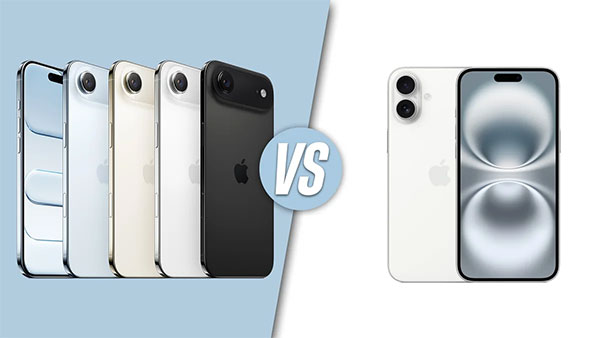
It's exciting to compare the new iPhone 17 Air with its predecessors, especially the iPhone 16 Plus. While both share some features, there are also some important differences between them. In this article, we'll dive into all the similarities and contrasts to help you understand how the two stack up.
|
iPhone Air
|
iPhone 16 Plus
|
|
New thin design with a redesigned camera housing.
|
The flat-edge design seen in recent generations
|
|
The flat-edged design seen in recent generations
|
Aluminum frame
|
|
New camera housing design
|
Old square camera bump
|
|
120Hz ProMotion OLED display, but more durable and power efficient
|
60Hz refresh rate
|
|
Slightly smaller 6.5-inch OLED display
|
6.7-inch display with 1290 x 2796 pixels resolution
|
|
New Apple A19 Pro chip built on a next-gen 3nm process
|
Apple A18 chip with great performance
|
|
12GB of RAM
|
8GB of RAM
|
|
Single 48MP wide camera
|
The same 48MP main camera but additional 12MP ultrawide
|
|
18MP center stage front camera
|
12MP selfie camera
|
|
3000 mAh battery, potentially shorter battery life
|
Bigger 4674 mAh battery
|
|
MagSafe support
|
MagSafe support
|
Design and Size
This year, Apple introduced a major design shift with the iPhone 17 series. The Pro models now feature a completely new camera housing, which is quite different from the previous design. Meanwhile, the iPhone 17 Air has been updated with a more subtle, refined look.
The iPhone 17 Air sports a sleek single camera bar, offering a much classier design compared to the large rectangular camera bump on the Pro models, known as the "extended plateau."
As for size, the iPhone 17 Air is only 5.6 mm thick, making it lighter than the iPhone 16 Plus, which weighs 199 grams. The Air comes in at just 165 grams.
In terms of build, the iPhone 17 Air is made with titanium and Apple's Ceramic Shield 2 on both the front and back, making it the most durable iPhone ever. The iPhone 16 Plus, however, uses an aluminum frame with glass on the front and back, showing a noticeable difference in materials.
Display Differences
Apple has introduced the iPhone 17 series, and all models now feature ProMotion with a smooth 120Hz refresh rate – a much-awaited upgrade!
The iPhone 17 Air comes with a 6.5-inch OLED display, boasting a resolution of 1320 x 2868 pixels (458 PPI) and a peak brightness of 3,000 nits, making it brighter than the iPhone 16 Plus.
In comparison, the iPhone 16 Plus has a 6.7-inch screen with a resolution of 1290 x 2796 pixels (460 PPI), but it only supports a 60Hz refresh rate. Its brightness peaks at just over 1000 nits at full brightness.
Rumors suggest the iPhone 17 Air includes new LDTEE technology, which improves efficiency and durability. We'll confirm this once we get our hands on the device and run full display tests. Stay tuned!
Performance and Software
The iPhone 17 Air is powered by the new A19 chip, offering 40% better sustained performance than last year's Pro models, and even more compared to the A18 in the non-Pro models. We'll have more precise numbers once we run our benchmarks.
In terms of RAM, the iPhone 17 Air has 12GB (still unconfirmed), while the iPhone 16 Plus has 8GB.
Apple has also bumped up storage for the iPhone 17 Air, starting at 256GB, while the iPhone 16 Plus starts at 128GB.
The iPhone 17 Air ships with iOS 26, which the iPhone 16 Plus will also get later in September. Check out our early iOS 26 preview for more details.
Camera
Apple has gone with a single 48MP main camera again for the iPhone 17 Air, similar to the iPhone 16e. While Apple claims this 48MP Fusion camera works like four lenses, it's still unclear how much of that is true.
The iPhone 16 Plus offers an extra ultrawide camera with a 12MP sensor and a 13mm focal length. Neither phone includes a telephoto lens, so you'll need to crop the main sensor for zoomed-in shots.
The iPhone 17 lineup gets a new 18MP selfie camera that allows for horizontal selfies while holding the phone vertically, adjusting the crop based on how you hold it.
In our camera benchmark, the iPhone 16 Plus scored 149, which is solid despite the lack of telephoto. It'll be interesting to see how the iPhone 17 Air compares. For reference, the iPhone 16e scored only 118, so we're curious to see if the Air can do better once we run our full tests.
Battery and Charging
Apple has always been cautious about battery specs, and while they've mentioned larger batteries for the iPhone 17, they haven't disclosed exact numbers—only video playback times.
Reports suggest the iPhone 17 Air has a 3,000 mAh battery, which seems decent given the phone's size. However, we'll need teardowns to confirm the exact figure.
In comparison, the iPhone 16 Plus packs a much bigger 4,674 mAh battery, ranking #38 in battery tests with a 7h 31m composite score.
As for charging, Apple didn't reveal much, but the inclusion of a MagSafe battery accessory suggests the iPhone 17 Air supports wireless charging, a significant achievement for a device of its thickness.
Summary: Which One to Choose?
Do we really need ultra-thin phones? That's the main question when considering the iPhone 17 Air. Priced at $899, it's close to the iPhone 17 Pro, but with fewer cameras and a thinner build. Where does the iPhone 16 Plus fit in?
The iPhone 17 Air improves on the screen (now with ProMotion) and has a faster chip, tougher materials (titanium and Ceramic Shield 2), plus more RAM and storage.
However, it sacrifices one camera and a bigger battery compared to the iPhone 16 Plus, while costing more. If you want a large-screen iPhone and don't mind a thicker design, the iPhone 16 Plus is a solid choice. But if you're after the thinnest option on the market, the iPhone 17 Air is worth the extra $100.
You May Be Interested in:
Bonus: Copy Data to Your New iPhone 17 Safely and Easily
I believe you now know what to choose between the iPhone 16 and 17. In short, owning a new iPhone is certainly exciting. But don't forget to choose a professional and reliable data transfer tool to help you transfer data from your old device to the new iPhone. MobiKin Transfer for Mobile is a professional and reliable tool that can transfer data from your old iPhone or Android phone to your new iPhone 17/17 Pro/Air, ensuring your data is safely transferred without any hassle.
Key Features of MobiKin Transfer for Mobile:
- Transfer data between iPhone, Android, and even from iPhone to Android, and Android to iPhone.
- Easily transfer photos, videos, contacts, messages, and more.
- Ensure that all your important data remains intact during the transfer.
- Quick transfer speeds save you time while moving your data.
- Fully compatible with iPhone 17/17 Pro (Max)/Air and other iPhone models.
How to Transfer Data from Your Old Device to iPhone 17 Using Transfer for Mobile:
Step 1: Connect Both Devices to Your Computer
Download MobiKin Transfer for Mobile and install it on your computer. Connect both your old device and new iPhone to the computer using USB cables.
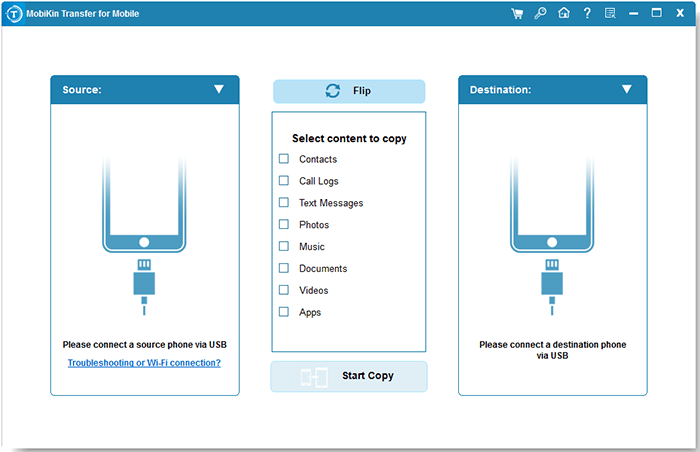
Step 2: Select the Data You Want to Transfer
Once connected, the software will detect both devices and display them side by side. Make sure the new iPhone 17 is located on the right. Choose the data types you want to transfer.

Step 3: Start the Transfer Process
Click "Start Copy" to begin moving your selected data from the old device to your new iPhone. Wait for the transfer to complete. Your new iPhone will now have all your data ready to use.
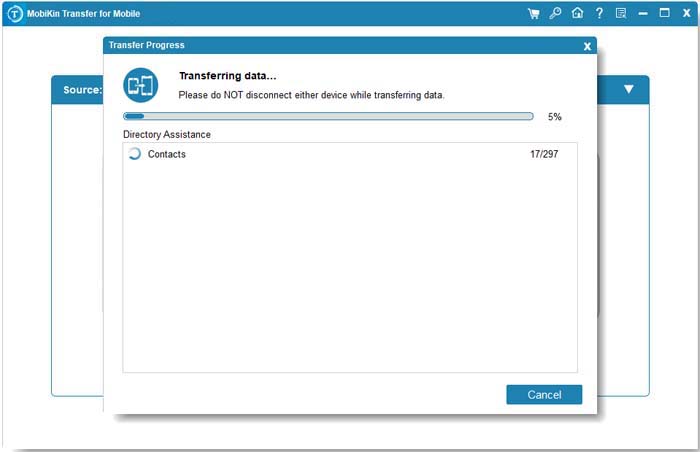
Video Guide:
Related Articles:
[Guide] How to Pre-order iPhone 17: Ship Dates & Prices
10 Best iPhone Backup Software in 2025 for Windows PC/Mac
[Reviews] Top 6 iPhone Data Eraser Software to Wipe iPhone Permanently



